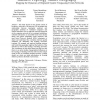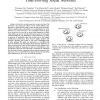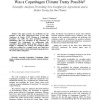ASUNAM
2015
IEEE
9 years 8 months ago
2015
IEEE
Abstract—We develop in this paper a trend detection algorithm, designed to find trendy topics being disseminated in a social network. We assume that the broadcasts of messages i...
106
click to vote
ASUNAM
2015
IEEE
9 years 8 months ago
2015
IEEE
—Social media (e.g., Facebook and Twitter) serves as a popular platform for online communication and information dissemination, where users can effectively share information such...
ASUNAM
2015
IEEE
9 years 8 months ago
2015
IEEE
Abstract—A variety of massive datasets, such as social networks and biological data, are represented as graphs that reveal underlying connections, trends, and anomalies. Communit...
ASUNAM
2015
IEEE
9 years 8 months ago
2015
IEEE
— this study focuses on the spatial context of hacking to networks of Honey-pots. We investigate the relationship between topological positions and geographic positions of victim...
160
click to vote
ASUNAM
2015
IEEE
9 years 8 months ago
2015
IEEE
—Fraud is a social process that occurs over time. We introduce a new approach, called AFRAID, which utilizes active inference to better detect fraud in time-varying social networ...
ASUNAM
2015
IEEE
9 years 8 months ago
2015
IEEE
—This paper presents our predictions for the outcomes of the most controversial issues at the 15th Conference of Parties (COP) Meeting in Copenhagen, December 7-15, 2009. For the...
ASUNAM
2015
IEEE
9 years 8 months ago
2015
IEEE
Abstract—In an ever-increasing variety of contexts, people are working collaboratively to solve problems and accomplish tasks. Yet the characteristics of effectively functioning ...
ASUNAM
2015
IEEE
9 years 8 months ago
2015
IEEE
—Who are the best targets to receive a call-for-paper or call-for-participation? What kind of topics should we propose for a workshop or a special issue of next year? Precisely p...
ASUNAM
2015
IEEE
9 years 8 months ago
2015
IEEE
Abstract—Sentiment classification has become a ubiquitous enabling technology in the Twittersphere, since classifying tweets according to the sentiment they convey towards a giv...
0
posts
with
0
views
0
views





